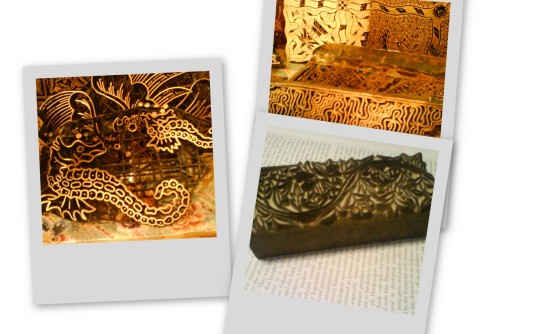Batik is a beautiful piece of art on fabric. Creatively crafted by using 3 main wax-resist dyeing techniques (we shall next explore these in a separate article), the process of batik creation is an ancient art that is kept alive, relevant and vibrant till today.
We shall explore many facets of batik and touch several areas such as its tradition, the various techniques of creation, modern interpretations, meet various peoples in the industry, learn where to find batik, types of batik, traditional meanings of different kinds of batik, the fabrics used, and much more.
Along the way, we invite you to share and ask of anything regarding batik.
~~~~~~~~~~~~~~~~~~~~~~~~~~~~~~~~~~~~~~~~~~~~~~~~
 A good place to begin would be the roots of batik. Batik today exists in all continents in the world (except perhaps Antartica?). And according to Wikipedia, it is a very ancient tradition which begin more than a thousand years ago, with evidences from countries such as ancient Egyptian and Sumerian kingdoms. Now, that may come as surprising news, as batik is traditionally and mostly associated with Java in Indonesia. We are not suggesting that batik from Java and in many other places in the world such as African and other Asian countries have a common origin and spread from the same tradition. Rather, we believe that people in different parts of the world have created batik cloths at different periods of time, and some of these are native creations, independent of ancient foreign influences and ideas.
A good place to begin would be the roots of batik. Batik today exists in all continents in the world (except perhaps Antartica?). And according to Wikipedia, it is a very ancient tradition which begin more than a thousand years ago, with evidences from countries such as ancient Egyptian and Sumerian kingdoms. Now, that may come as surprising news, as batik is traditionally and mostly associated with Java in Indonesia. We are not suggesting that batik from Java and in many other places in the world such as African and other Asian countries have a common origin and spread from the same tradition. Rather, we believe that people in different parts of the world have created batik cloths at different periods of time, and some of these are native creations, independent of ancient foreign influences and ideas.
Batik is almost synonymously associated with Indonesia and it comes to no surprise when one encounters traditional batik found there. Its intricate and elaborate designs which are rich in symbolic meanings and the batik diversity there is most interesting, and batik was and still is, so commonly used by the people of all walks of life, the common folk and the royal courts and palaces (kratons) alike. Modern Indonesians pride themselves in batik which has somewhat attained a status of the national clothing of Indonesia. They take great lengths to produce excellent batik till today, and their pride and passion in batik making are some reasons why batik is still very much connected to Indonesia.
Neighbouring countries such as Malaysia, Singapore and Brunei share the same batik tradition as Indonesia. These countries are collectively called the Malay Archipelago and besides sharing a common lingua franca, i.e. the Malay language (or officially known as Bahasa Melayu or Bahasa Indonesia), have much in common culturally though each has its distinctive traits and has evolved differently based on different socio-economic, cultural and political threads.
Batik was worn and is commonly used in the people there, both women and men of various communities and ethnic backgrounds. Although ceremonial usage requires excellent batik, it is also a comfortable and highly practical daily wear. For example, a piece of batik sarong (somewhat a “tube” in today’s fashion sense) has great flexibility for room and growth.This allows the wearer to use it even as their girths expanded (and vice versa, naturally) since all one needs to do is to fold and “wrap” the cloth over ones body and waist. This means there is no typical S, M, L or XL sized cloths are needed since the height is almost always the same yet the width of the cloth can wrapped more or less around the waist. A smart creation, we must say. Easier for people to buy sarongs as long as one likes the piece, and also we can share it with others without concerns of the size and it becomes a piece we could use on and on. In fact, people of old used to use pieces for decades even if their girths had increased along the way!
Batik has come a long way since and is now globally adored and perpetuated. While Jakarta and Kuala Lumpur and other cities, towns and villages in Indonesia, Malaysia and Singapore have continued this tradition, we are seeing new forms of batik everywhere. Fashion cities such as Hong Kong, Milan, London are ever keen to explore batik and greater interests in the art and fabric has reached even Europe and the USA with home-grown talents. This is great news because there are newer ideas, fashions and diversity in batik.
In terms of form and art, batik today has evolved from clothing to haute couture and even new utilitarian objects including curtain drapes, bed set sheets, mobile phone cases, handbags & wallets, table & chair runners, cushion sets, key-chains and many more!
Indeed the batik story is an ancient one in a modern world 🙂
Technorati Profile
Filed under: Batik History | Tagged: batik, batik culture, Batik History, batik indonesia, batik malaysia, canting, cap, ikat, java, tjanting, tulis | Leave a comment »





 A good place to begin would be the roots of batik. Batik today exists in all continents in the world (except perhaps Antartica?). And according to
A good place to begin would be the roots of batik. Batik today exists in all continents in the world (except perhaps Antartica?). And according to